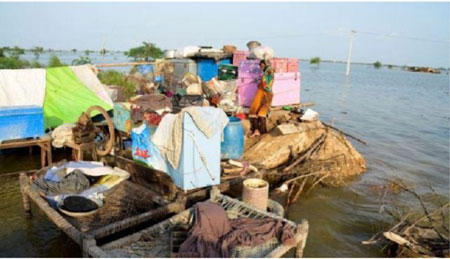The impact of climate change on health if carbon emissions remain high, could be up to twice as deadly as cancer in some parts of the world, includ-ing Pakistan, according to new data released Friday by the UN Development Programme (UNDP) and the Climate Impact Lab.
The new data shows the need to act quickly, not only to mitigate climate change but also to adapt to its consequences.
For instance, in Faisalabad, Pakistan, even with moderate mitigation, additional deaths due to climate change would average 36 per 100,000 people each year between 2020-2039, according to the data. Without substantially expanding adaptation efforts, Faisalabad could expect annual climate change-related death rates to nearly double, reaching 67 deaths per 100,000 by mid-century. An increment almost as deadly as strokes, currently Pakistan’s third leading cause of death.
“As we face the punishing impacts of global climate change it can be easy to wonder whether efforts to reduce emissions by individual countries, states, or cities really make a difference. This plat-form shows the direct role these efforts play in shap-ing our collective future,” Climate Impact Lab’s Hannah Hess, Associate Director at Rhodium Group.
In Dhaka, Bangladesh, where under a scenario of very high emissions by 2100, additional deaths due to climate change could rise to nearly twice the country’s current annual death rate from all cancers, and 10 times its annual road traffic fatalities, ac-cording to the data.
“Because of human action, the concentration of carbon dioxide in our atmosphere is reaching dan-gerous levels, driving Earth’s temperatures higher and amplifying the frequency and intensity of ex-treme events,” says the newly launched Human Climate Horizons platform, adding that without concerted and urgent action, climate change will further exacerbate inequalities and uneven devel-opment.
Building on the analyses of 2020, 2021 and 2022 Human Development Reports — and fed by an evolving stream of frontier research — the data shows how climate change can impact people’s lives — from mortality to livelihoods, and energy use.
Although higher temperatures and a warmer climate put cardiovascular and respiratory systems under stress everywhere, outcomes will vary between places, according to communities that have the re-sources to adapt and those that do not.
The data shows that climate change could in-crease mortality rates in Faisalabad, Pakistan by nearly 67 deaths per 100,000 population — causing more fatalities than strokes, the country’s third lead-ing cause of death.
In Riyadh, Saudi Arabia, however, higher in-comes could keep the death toll to 35 per 100,000, which is still deadlier than Alzheimer’s disease — the sixth leading cause of death globally.
Since the late 19th century, the earth’s average temperature has risen by nearly 1.2°C, changing the entire surface area of the planet, according to the research.
However, billions live in regions that have al-ready experienced warming greater than the global average. As an example, the platform pointed to Maracaibo, Venezuela, noting that in the 1990s it averaged 62 annual days with temperatures exceeding 35°C. However, by mid-century, that number will likely soar to 201 days. Electricity availability and fuels used to generate it to power air conditioners and heaters, play a crucial role in our ability to cope with extreme temperatures, said UNDP.
Yet, the impacts of climate change on energy use will vary locally, as individuals, communities and businesses adapt to conditions using available re-sources.
In Jakarta, for example, electricity consumption in response to warmer temperatures is projected to increase by roughly one-third of current household consumption in Indonesia.—APP










